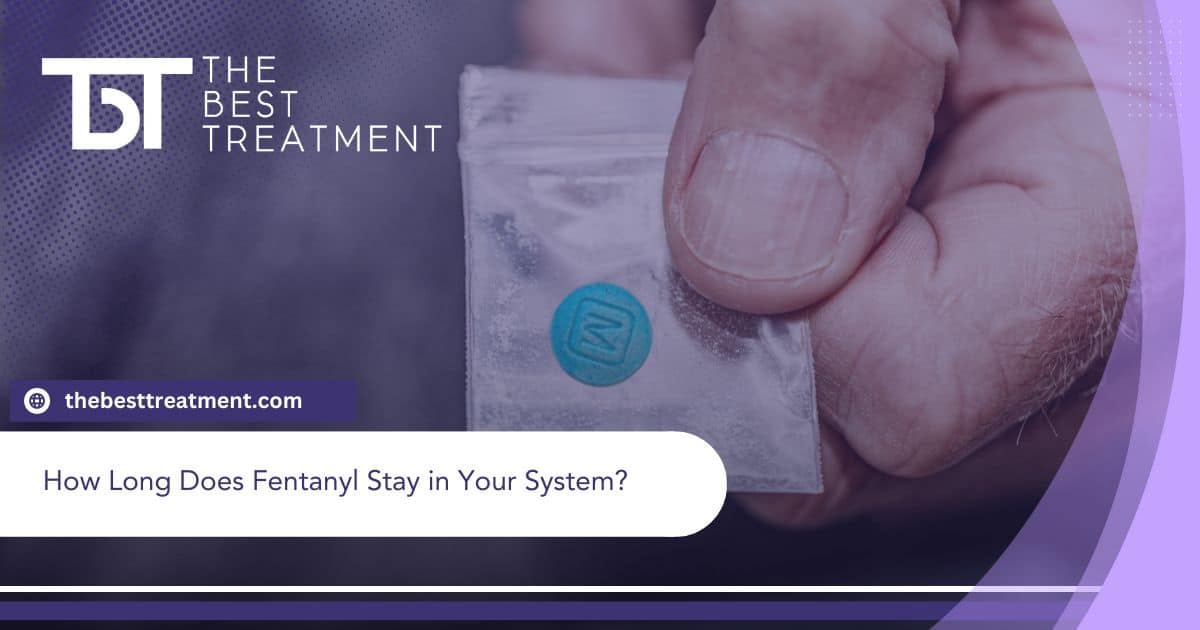Table of Contents
Opioid abuse and addiction are serious problems in the United States, with both prescription and illicit opioid use on the rise. The result of increased opioid abuse is a flood of overdoses and deaths. At the forefront of these deadly complications is a drug called fentanyl.
Fentanyl is a potent, addictive drug that is deadly in tiny doses. While fentanyl is only intended for use in medical settings under close observation, many people use it recreationally or ingest it unintentionally while using other illicit drugs.
Fentanyl is used in medical settings to relieve moderate to severe pain. While it is considered safe when used under careful medical supervision, illicit use can quickly lead to a life-threatening addiction.
People who use fentanyl recreationally or who abuse their prescription must seek immediate addiction treatment to regain control over their substance use and prevent severe, possibly life-threatening complications.
This article will explore the effects of fentanyl, how long does fentanyl stay in your system, and how to find the comprehensive treatment you need to overcome fentanyl addiction. Reach out to the team at The Best Treatment now to learn about our holistic, supportive addiction treatment programs or to schedule an intake assessment.
What is Fentanyl?
Fentanyl is a potent, synthetic opioid that doctors can prescribe to help their patients manage moderate to severe pain. Fentanyl is available in several forms, including:
- Injectable liquid
- Tablets
- Nasal spray
- Patches
- Lozenges
- Powder (the most common type of illicit fentanyl)
Fentanyl works by binding to opioid receptors in areas of the brain related to pain control and pleasure. It is effective at reducing severe and chronic pain but also produces a pleasurable sedative and euphoric “high” effect, which can make users want to use it differently than prescribed.
People may become addicted to fentanyl if they take higher or more frequent doses of fentanyl or if they use it recreationally–meaning without a prescription. It is also possible for people to become physically dependent on fentanyl even when taking it as prescribed.
Fentanyl is so potent and addictive that users often require professional treatment and ongoing support to stop using the drug and avoid relapse. People who use it recreationally must seek treatment as quickly as possible. Those who take prescription fentanyl must be aware of the signs of fentanyl addiction and seek treatment as soon as they recognize a problem.
How Long Do the Effects of Fentanyl Last?
The duration of fentanyl’s effects can vary based on how it’s administered. When used as a pain reliever in a medical setting, the effects can last for a few hours, typically around 1 to 2 hours for the intravenous form and up to 4 hours for the transdermal patch.
However, illicitly used fentanyl, especially in its more potent forms like carfentanil, can have a rapid onset and shorter duration, often lasting for a shorter period, around 30 minutes to an hour.
The duration and intensity can also be influenced by various factors including the individual’s metabolism, tolerance, and the dosage taken.
How Long Does Fentanyl Stay In Your System?
Fentanyl remains in your system longer than it takes for you to stop feeling its effects. Fentanyl has a half-life of 3-7 hours, meaning half of the amount of the drug will be eliminated in 7 hours. Medical experts believe that it takes about 35 hours for your body to metabolize fentanyl completely.
However, drug screening can detect fentanyl for longer periods. Here are some examples of how long different types of drug testing may detect fentanyl metabolites.
- Urine: 24-72 hours
- Blood: 5-48 hours
- Hair: Up to 3 months
- Saliva: Not consistently detectable
The most commonly used type of drug test is a urine test. While these can only detect fentanyl in the body for 24-72 hours, they are easy to administer, affordable, and highly accurate. Urine tests may be used for pre-employment screening and other purposes.
Blood tests are typically only used in medical settings. They have a short fentanyl detection window of 5-48 hours, so they are generally used to confirm intoxication or test for substances that are currently in the system.
Hair tests are gaining popularity due to their long detection window. Fentanyl and other drugs can be detected on a hair test, which screens for metabolites of substances in the hair follicle, for up to 90 days.
The length of time fentanyl remains in your system depends in part on how much of the drug you took and how you ingested it. Weight, gender, general health, and the frequency of use can also impact how long fentanyl stays in your system.
Factors that Affect How Long Fentanyl Stays in Your System
Several factors can influence how long fentanyl remains detectable in the body, including:
- Metabolism – Individual metabolic rates can affect how quickly the body processes and eliminates fentanyl. People with faster metabolisms will eliminate the drug more quickly.
- Dosage and Frequency of Use – Higher doses or frequent use can extend the time fentanyl stays in the body. Chronic use can also lead to fentanyl accumulation in tissues, prolonging its presence in the system.
- Body Composition – Body weight, fat percentage, and hydration levels can impact fentanyl metabolism and elimination rates.
- Liver and Kidney Function – Efficient liver and kidney function play significant roles in metabolizing and eliminating substances from the body. Impaired function can prolong the drug’s presence.
- Age – Metabolic rates tend to slow down with age, potentially impacting how long fentanyl stays in the system, especially in older individuals.
- Genetics – Variations in metabolic enzymes due to genetic factors can affect how quickly or slowly fentanyl is processed by the body.
- Polysubstance Use – Concurrent use of other drugs or medications can influence the metabolism and excretion of fentanyl, either prolonging or shortening the length of time it stays in the body.
- Route of Administration – Different forms of fentanyl have varying absorption rates and durations. For instance, intravenous fentanyl may have a shorter duration compared to transdermal patches.
- Health Conditions – Certain health conditions affecting metabolism or kidney and liver function can impact the elimination of fentanyl from the body.
Understanding Fentanyl Withdrawal
The only way to flush fentanyl out of your system is to stop taking it. When people with physical dependence on fentanyl suddenly stop using the drug, they are likely to experience withdrawal symptoms. Fentanyl withdrawal can be highly uncomfortable and includes intense physical and emotional withdrawal symptoms, including:
- Nausea
- Loss of appetite
- Increased heart rate and blood pressure
- Excessive sweating
- Chills
- Insomnia
- Anxiety
- Muscle weakness
- Diarrhea
- Intense, persistent cravings
Many people are unable to withstand the severity of their withdrawal symptoms, and relapse before detox is complete. Professional medical and emotional support are critical during fentanyl withdrawal.
How Long Does Fentanyl Withdrawal Last?
Fentanyl withdrawal symptoms typically last until your body has eliminated fentanyl from the system and your body has readjusted to the lack of the drug. This timeline can vary from person to person, depending on the severity of their addiction and other factors.
People in fentanyl withdrawal–or those anticipating it–may wonder how long fentanyl stays in your system and when they can expect to feel relief from their symptoms. While the fentanyl withdrawal timeline can vary for each person, here is an example of how long fentanyl withdrawal may last.
8-48 hours
Withdrawal symptoms typically begin within about 8 hours of your last dose of fentanyl. However, fentanyl and other long-acting opioids can take longer to clear your system. Symptoms may not develop for up to 48 hours in some cases.
4-20 days
Fentanyl and other long-acting opioids typically have a longer withdrawal timeline than short-acting drugs. People are likely to experience physical symptoms, like muscle weakness, nausea, chills, and sweating, as well as depression, anxiety, and depression for the first one to three weeks. Symptoms fluctuate in intensity throughout the withdrawal period.
After 20 days
Some people develop a prolonged form of fentanyl withdrawal called Post-Acute Withdrawal Syndrome (PAWS). People who develop PAWS can experience withdrawal symptoms for weeks or months after the acute withdrawal period. PAWS is more likely to occur in people who have chronic pain or mood disorders.
Fentanyl withdrawal can test people’s physical and emotional limits. It’s crucial to have professional treatment and support to have a safe, complete detox. After completing detox, people with fentanyl addiction must continue in a comprehensive treatment program that will address the physical, behavioral, and psychological aspects of their substance use.
Find Help For Fentanyl Abuse and Addiction Now
If you or a loved one are struggling with fentanyl addiction, you can find information, treatment, and support at The Best Treatment. Our comprehensive fentanyl addiction treatment programs are designed to empower people as they work toward lifelong recovery from addiction. Contact us now to learn more or to schedule an intake evaluation.
Medically Reviewed: September 25, 2019

All of the information on this page has been reviewed and verified by a certified addiction professional.










